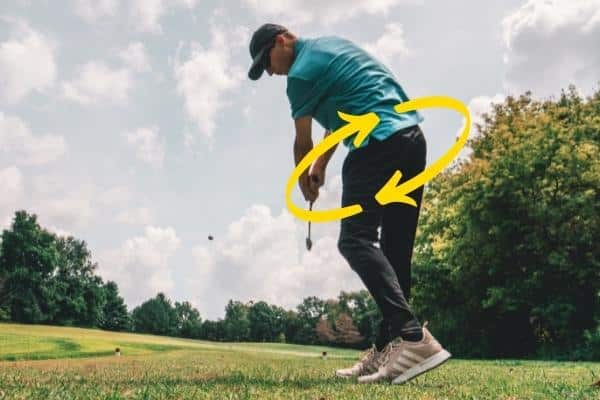Getting stuck in the downswing is something I’ve battled in my own golf game for a long time.
Usually the biproduct of a too in-to-out or under plane club path, many instructors I’ve had lessons from say getting stuck is the sign of a good golfer as it’s far closer to a good swing than an out-to-in, over-the-top slice.
But, as I can attest from experience, getting stuck in your downswing can be debilitating for your game if not remedied and can lead to nasty blocks, or roping duck hooks – neither of which are conducive to scoring well.
In this article, I’ll explain everything you need to know about getting stuck in the downswing – what it means, why it happens, and how you can fix it.
Table of contents
What does ‘getting stuck’ mean in golf?
Getting stuck in golf is when your club drops way under plane in the downswing, coupled with your hips thrusting towards the ball and failing to open at impact. To compensate, you will likely stand up out of your posture and throw your hands at the ball, losing all your lag and clubface control.
The reason it’s called ‘getting stuck’ is because it’s exactly what happens – if your club is way under plane in the downswing, there is no room for it to move around your body when you begin to rotate your hips open.
To try and create space, your hips stall, your legs stand up and you throw the clubhead at the ball.
If you videoed someone who gets stuck in their downswing, there would be some tell-tale signs that would highlight the flaws.
Firstly, their hips would be pointing almost square at the ball at impact, and likely have come away from their starting buttock line.
Secondly, their arms will be nearly fully straight as they strike the ball, rather than relaxed with their trail elbow bent; this is because they’ve stood up out of their posture, with the only way to reach the ball being to fully extend their arms.
And thirdly, the shaft of the golf club will be incredibly steep, usually with the toe pointed down at impact.
If you record your own swing and notice any of these things, there’s a good chance you may be getting stuck.
Why am I getting stuck in the downswing?
The main reasons for getting stuck in the downswing include losing your posture and early extending; a club path that is too far from the inside; failing to open your hips and chest through impact; or firing your hips too early. Any combination of these flaws will lead to getting stuck in the downswing.
As someone who has had many lessons and constantly battles these three swing faults in my own game, I can confidently say they are the most common causes when it comes to getting stuck.
The movement of the hips are a particularly fine line to balance: fire them too early, and you’ll leave the club behind you; don’t fire them enough, and you won’t create enough room for the club to move around your body.
Below, I’ve elaborated on each of the above flaws to explain in more detail why they contribute to you getting stuck in the downswing.
Flaw #1: Losing your posture
Standing up out of your posture during the downswing is one of the leading causes for getting stuck.
The best players in the world will keep their shape throughout their entire swing, whereas a lot of amateurs won’t – instead, they’ll stand up and thrust their hips towards the ball (otherwise known as early extension).
Doing this will the reduce the amount of space between you and the ball, leaving less room for your hands and club to swing through the impact zone.
As a result, the club can get stuck behind your body and you’re left to try and manipulate it by steepening the shaft or flipping the clubhead at the ball in order to make contact.
Flaw #2: Club path is too inside
This swing fault is usually a bi-product of losing your posture, as explained above, however it can also be caused by an excessively flat backswing (think young Rickie Fowler, but flatter).
Dumping the club way under plane in the downswing means you have little margin for error when it comes to opening your hips – too early, and the club will get stuck behind you; too early, and you’ll tend to want to ‘flip’ at the ball in order to make decent contact.
Getting your club moving on a more neutral path creates way more space between you and the ball, meaning your hands can move freely through the impact zone without needing to manipulate the clubface.
Flaw 3: Failure to open hips and chest
This swing flaw is often brought about by a club path that is too far from the inside (demonstrating how one little fault can have a flow-on effect throughout the rest of your swing).
If your swing is excessively in-to-out, the natural reaction from your brain is to keep your hips and chest closed in order to strike the golf ball – without doing so, it’s likely you’d miss it altogether.
However, while you may hit the occasional good shot, you’ll likely struggle with consistency and forever be battling duck hooks or big blocks.

What happens when you get stuck in the downswing?
When you get stuck in your downswing, one of three things will likely happen: either you’ll hit a block; hit a hook; or you’ll manage to hit a decent shot, depending on if you’ve married-up your body and hand movements well enough.
If this describes you, then don’t worry, you’re not alone – this is a typical round for many mid-handicap golfers who shoot in the 80s or 90s.
While a lot of shots will be good, there will be a few that can be round destroying.
If you want consistency, you want to avoid getting stuck as much as possible as it’s an inefficient way to swing the golf club.
Removing variables such as overactive wrists and hands, which can be a biproduct of poor rotation and early extension, will improve your consistency.
How do I stop getting stuck in the downswing?
The best way to stop getting stuck in the downswing in golf is to practice the appropriate drills, which focus on getting your club on a neutral plane, as well as getting you to open your hips correctly and maintain your posture.
Below are two drills that will help you do this.
Drill #1: Prevent an inside takeaway
This drill is so simple, yet so effective for keeping your club on plane in the backswing and downswing to prevent it getting stuck.
It’s best to perform it on a driving range, or somewhere that you can hit off of grass.
First, take your stance, then grab an alignment stick and place it into the ground a club length behind where the ball would be, but also move it around a foot towards you.
Make sure the alignment stick is tilted in a way that matches the shaft angle you have at address.
The idea of the drill is to make gentle half or three-quarter swings without letting your club hit the alignment stick in both the takeaway and downswing – if it does, it means the club is coming too far from the inside.
Doing this drill regularly will teach you to get the club moving more on plane, rather than excessively around your body, which will stop it getting stuck.
Drill #2: Butt against a chair
This is one of the easiest ways to practice opening your hips correctly while maintaining your spine angle and preventing early extension, which will stop the club getting stuck behind you in the downswing.
Simply place a chair behind your backside when you’re hitting into your practice net at home (you can use an alignment stick if you’re at the range) and address the ball with your butt cheeks keeping in contact with it.
Take some swings and focus on keeping your backside touching the chair until your strike the golf ball – only after it’s gone can you allow your cheeks to come away from the chair.
Working on this drill will stop you from thrusting towards the ball by teaching your body to pivot properly and maintain enough space to let your hands move through the impact zone, without getting stuck.
Final message
Getting stuck in the downswing in golf is often the biproduct of a number of other mechanical flaws in your swing, namely hip rotation and an excessively in-to-out club path.
Focusing on getting your club on a more neutral path is the first step to success and will make an immediate difference, while working on getting your hips open and staying in posture are equally important.
If you can correct those movements, getting stuck in the downswing will be a thing of the past.


